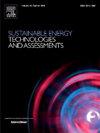In-situ sampling of solid recovered fuel and recycling ashes for the production of sustainable binders
IF 7.1
2区 工程技术
Q1 ENERGY & FUELS
Sustainable Energy Technologies and Assessments
Pub Date : 2025-01-01
DOI:10.1016/j.seta.2024.104139
引用次数: 0
Abstract
Increasing waste generation and energy shortages are fueling interest in alternative fuels such as solid recovered fuels (SRFs), but limited studies address their compositional properties and potential for reuse in construction. This study involved in-situ sampling at SRF production/utilization facilities in Taiwan, with five sites substituting 30 %–80 % of their fossil fuels use with SRFs derive mainly from plastics, textiles, and waste wood. The net calorific values of SRFs ranged from 18.42 MJ/kg to 29.11 MJ/kg with textile-derived SRFs containing higher sulfur (3.23 %) and chlorine (0.03 %) levels. After incineration, SRF ashes showed increased concentrations of metals, notably Ca (0.09–30.2 %), followed by Si (4.17–18.95 %), and Fe (1.15–5.86 %). Metals such as aluminum and iron were found to be more concentrated after incineration. The compressive strength of ash-based binders increased with curing time, achieving 291 kgf/cm2 at 30 % SRF ash content after 14 days. The study suggests that replacing approximately 10 % of cement with SRF ash and curing for 7 days optimizes viscosity, permeability, and compressive strength. These findings support the circular economy by repurposing SRF ashes for civil and environmental applications.

求助全文
约1分钟内获得全文
求助全文
来源期刊

Sustainable Energy Technologies and Assessments
Energy-Renewable Energy, Sustainability and the Environment
CiteScore
12.70
自引率
12.50%
发文量
1091
期刊介绍:
Encouraging a transition to a sustainable energy future is imperative for our world. Technologies that enable this shift in various sectors like transportation, heating, and power systems are of utmost importance. Sustainable Energy Technologies and Assessments welcomes papers focusing on a range of aspects and levels of technological advancements in energy generation and utilization. The aim is to reduce the negative environmental impact associated with energy production and consumption, spanning from laboratory experiments to real-world applications in the commercial sector.
 求助内容:
求助内容: 应助结果提醒方式:
应助结果提醒方式:


